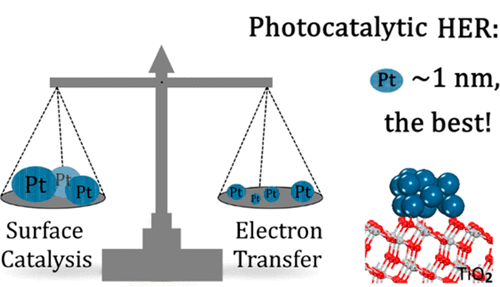当前位置:
X-MOL 学术
›
ACS Catal.
›
论文详情
Our official English website, www.x-mol.net, welcomes your feedback! (Note: you will need to create a separate account there.)
Revealing the Size Effect of Platinum Cocatalyst for Photocatalytic Hydrogen Evolution on TiO2 Support: A DFT Study
ACS Catalysis ( IF 12.9 ) Pub Date : 2018-06-22 00:00:00 , DOI: 10.1021/acscatal.8b01886 Dong Wang 1, 2 , Zhi-Pan Liu 2 , Wei-Min Yang 1
ACS Catalysis ( IF 12.9 ) Pub Date : 2018-06-22 00:00:00 , DOI: 10.1021/acscatal.8b01886 Dong Wang 1, 2 , Zhi-Pan Liu 2 , Wei-Min Yang 1
Affiliation

|
In heterogeneous catalysis metal particle morphology and size can influence markedly the activity, both in heat-driven and in electro-photocatalytic conditions. Because of the intimate coupling between the photoelectron transfer and the surface catalytic reaction, it has been challenging to determine the optimal metal particle size in photocatalytic reactions. Here, we utilize ab initio molecular dynamics and hybrid density functional theory calculations to reveal the size-dependent activity of photocatalytic hydrogen evolution reaction (HER) over Pt/TiO2 photocatalysts. By supporting four different Pt particles Pt5, Pt8, Pt13, and Pt19 on anatase TiO2(101), we determine the optimal geometries, the electronic structures, the photoelectron-transfer efficiency, and the surface hydrogen coupling reaction activity of these composite materials. We demonstrate that very small Pt clusters with less than two atomic layers are efficient photoelectron collectors from TiO2 bulk due to their low highest occupied molecular orbital level with respect to the oxide conduction band; by contrast, larger particles with more than two Pt layers are the active site for hydrogen coupling to catalyze HER. Our results suggest that quasi two-Pt-layer particles, corresponding to ∼1 nm size, are the best catalyst for photocatalytic HER. Compared to heat-driven and electrocatalysis, we conclude that photocatalysis prefers even smaller metal particles to enhance photoelectron transfer, which should be a general guideline for designing optimal photocatalysts in the future.
中文翻译:

DFT研究揭示了铂助催化剂在TiO 2载体上光催化制氢的尺寸效应
在非均相催化中,在热驱动和电光催化条件下,金属颗粒的形态和大小都会显着影响其活性。由于光电子转移与表面催化反应之间存在紧密的耦合,因此在光催化反应中确定最佳的金属粒径一直是一项挑战。在这里,我们利用从头算分子动力学和混合密度泛函理论计算来揭示Pt / TiO 2光催化剂上光催化氢释放反应(HER)的尺寸依赖性活性。通过在锐钛矿型TiO 2上支撑四个不同的Pt颗粒Pt 5,Pt 8,Pt 13和Pt 19(101),我们确定这些复合材料的最佳几何形状,电子结构,光电子转移效率和表面氢偶联反应活性。我们证明具有少于两个原子层的非常小的Pt团簇是TiO 2的有效光电子收集器由于它们相对于氧化物导带具有较低的最高占据分子轨道能级,因此具有体积;相比之下,具有两个以上Pt层的较大颗粒是氢偶联催化HER的活性中心。我们的研究结果表明,相当于1 nm大小的准两层Pt颗粒是光催化HER的最佳催化剂。与热驱动和电催化相比,我们得出的结论是,光催化更喜欢使用较小的金属颗粒来增强光电子转移,这应该是将来设计最佳光催化剂的一般指南。
更新日期:2018-06-22
中文翻译:

DFT研究揭示了铂助催化剂在TiO 2载体上光催化制氢的尺寸效应
在非均相催化中,在热驱动和电光催化条件下,金属颗粒的形态和大小都会显着影响其活性。由于光电子转移与表面催化反应之间存在紧密的耦合,因此在光催化反应中确定最佳的金属粒径一直是一项挑战。在这里,我们利用从头算分子动力学和混合密度泛函理论计算来揭示Pt / TiO 2光催化剂上光催化氢释放反应(HER)的尺寸依赖性活性。通过在锐钛矿型TiO 2上支撑四个不同的Pt颗粒Pt 5,Pt 8,Pt 13和Pt 19(101),我们确定这些复合材料的最佳几何形状,电子结构,光电子转移效率和表面氢偶联反应活性。我们证明具有少于两个原子层的非常小的Pt团簇是TiO 2的有效光电子收集器由于它们相对于氧化物导带具有较低的最高占据分子轨道能级,因此具有体积;相比之下,具有两个以上Pt层的较大颗粒是氢偶联催化HER的活性中心。我们的研究结果表明,相当于1 nm大小的准两层Pt颗粒是光催化HER的最佳催化剂。与热驱动和电催化相比,我们得出的结论是,光催化更喜欢使用较小的金属颗粒来增强光电子转移,这应该是将来设计最佳光催化剂的一般指南。



























 京公网安备 11010802027423号
京公网安备 11010802027423号